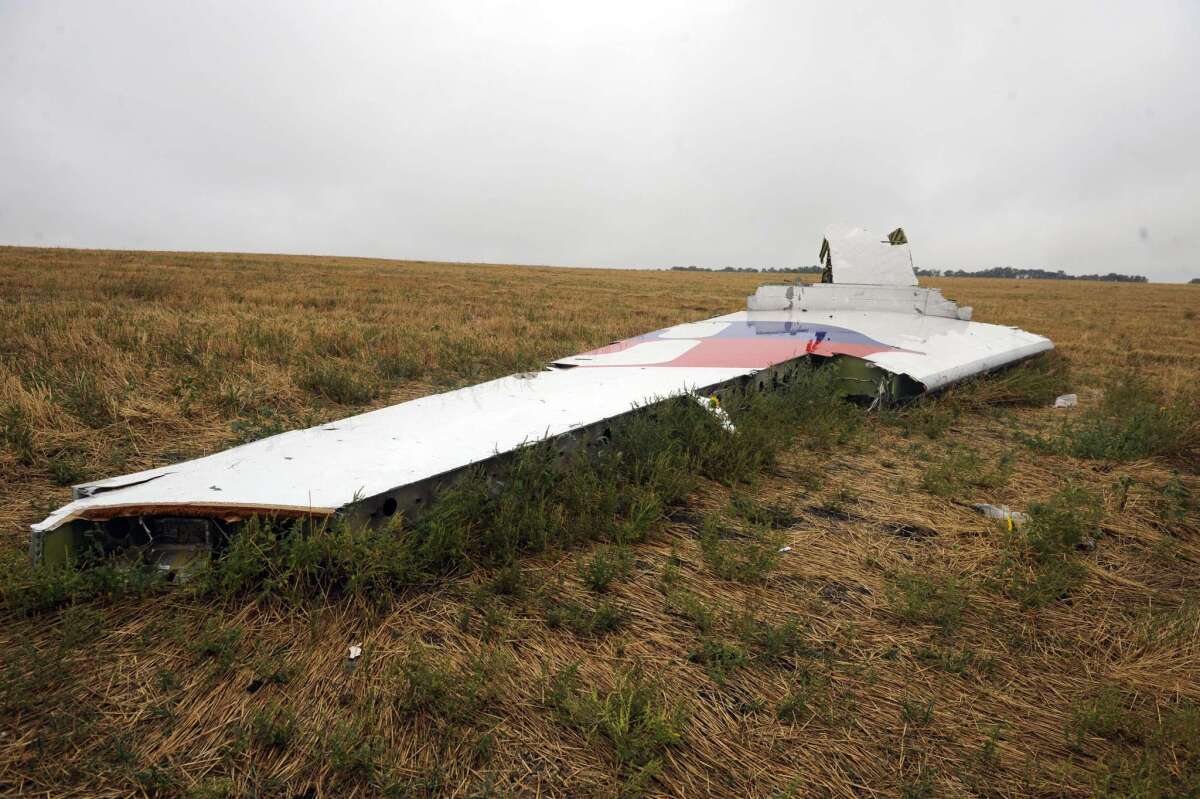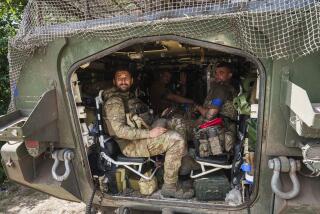Villagers in Ukraine cope with horrors of downed plane and fighting

- Share via
Reporting from Rozsypne, Ukraine — When bodies from doomed Malaysia Airlines Flight 17 fell from the sky and landed in this southeastern Ukrainian village in July, Ivan Savin knew the disaster would bring more problems.
It took three days for emergency workers to remove the decaying bodies from homes, driveways and cabbage rows.
A team of international investigators had turned up seeking answers about what caused the Boeing 777 to break into pieces while flying over separatist-held territory in Ukraine, killing all 298 people on board. The plane’s fuselage and human remains were spread for six miles across fields of wheat and sunflowers.
Then rocket fire and heavy shelling started, hitting several houses and the village’s only church, knocking off its silver-toned cupola. Within weeks, two residents of Rozsypne, a village of 5,000 people, were dead from artillery fire.
In response, many in the village took up arms and put on camouflage to stand guard at roadblocks to keep out the Ukrainian military forces they blame for turning this formerly quiet region into a deadly conflict zone.
Savin, a retired miner, said it was painful to watch his three young granddaughters dealing with the psychological scars of the violence.
“I was born 11 years after the victory over the German Nazis, and my generation was the first one that hadn’t seen a war on our land,” he said, as he excused himself for beginning to cry. “Now that’s all changed and I can’t explain to my granddaughters how or why this is happening.”
The conflict has also prevented air safety investigators from carrying out a full forensic analysis, but a preliminary report Tuesday by Dutch officials leading the investigation of what caused the Flight 17 disaster appeared to confirm initial assertions that the passenger plane had been hit by a surface-to-air-missile July 17. The plane, en route from Amsterdam to Kuala Lumpur, the Malaysian capital, was flying at about 33,000 feet.
The Dutch safety board’s report says that fragments of the aircraft reveal numerous puncture holes and indentations on the plane’s skin that would be consistent with damage from missile shrapnel and, investigators say, rule out pilot error or any mechanical fault as the cause of the disaster.
The plane’s cockpit voice and flight data recorders, often referred to as the “black boxes,” were not recovered by investigators but were removed from the wreckage by unknown individuals and turned over to a Malaysian official in the eastern Ukraine city of Donetsk several days after the crash.
Damage to the units was consistent with the nature of the crash, but their internal memory modules remained intact. They showed that communication from the crew gave no indication that anything had gone wrong with the flight.
U.S. intelligence sources said shortly after the crash that the plane had been destroyed by an SA-11 missile fired by a Russian-made Buk launching system fired from separatist-held territory.
Russian President Vladimir Putin has denied accusations that his government supplied the sophisticated antiaircraft launcher to the separatists, who have seized much of the Donetsk and Luhansk regions in a bid to retain Moscow’s influence in the predominantly Russian-speaking areas.
Nearly eight weeks after it exploded, the plane’s twisted and charred pieces are still lying in fields across this rolling landscape spotted with settlements like Rozsypne. The plane’s metal skeleton is among the reminders that the villages are in the middle of the intense fighting between Ukrainian government forces and separatists who Kiev says are backed and funded by the Kremlin.
Ukrainian forces have failed to retake these areas, which are claimed by the separatists’ self-declared Donetsk People’s Republic. Each village has armed forces to protect it from what residents say is a fascist junta based in Kiev. The belief that Kiev’s forces are trying to eradicate Russian speakers from the eastern regions of Ukraine is strong, even among those who speak a regional dialect known as Surzhyk, which mixes the Ukrainian and Russian languages.
“This is a civil war now, Ukrainians fighting against their brothers,” said Oleg, 44, of Hrabove, a hamlet of about 800 people, where the largest part of the plane’s fuselage landed less than 500 feet from his house. Oleg, who asked that his last name not be used for safety reasons, said he doubted Ukraine would ever be able to reunite as one country, or that this conflict would end anytime soon.
“It’s impossible now to live together, not after this,” he said, standing in his large garden behind his small house. He and his wife have been steadily stocking their cellar with the garden’s potatoes, jars of pickled tomatoes, canned peaches and apples, and homemade fruit compote for what they predict will be a long, difficult winter.
Hrabove, like Rozsypne, was hit by heavy artillery a few weeks ago. No one was hurt, but the shells hit the village graveyard and a nearby bird farm, according to the village priest, Father Sergei.
Overwhelmingly, people in Hrabove blamed the Ukrainian government and President Petro Poroshenko for the conflict that has now claimed more than 3,000 lives, many of them civilians, according to the United Nation’s most recent statistics.
Savin, meanwhile, said he no longer loves the country where he was born and raised.
“Poroshenko says he’s prepared to fight against Ukraine’s enemies,” Savin said. “But who are these enemies they are fighting against? I am Ukrainian! Do I look like a terrorist here?”
Special correspondents Ayres and Werth reported from Rozsypne and London, respectively.
More to Read
Sign up for Essential California
The most important California stories and recommendations in your inbox every morning.
You may occasionally receive promotional content from the Los Angeles Times.













